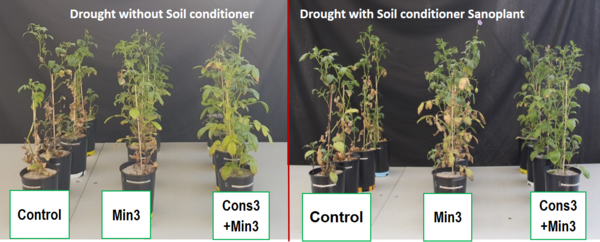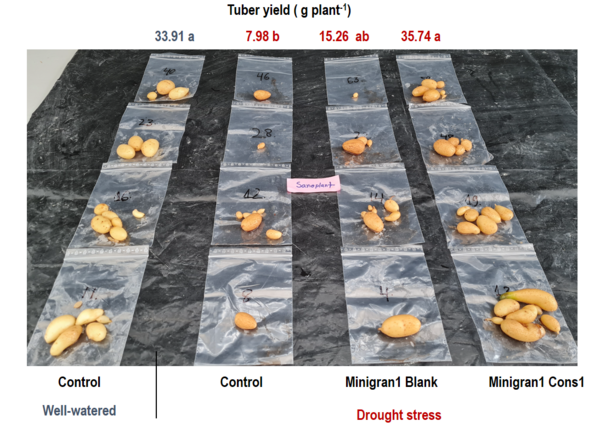SolACE partner DCM (a plant care company that develops, produces and markets biofertilisers, biostimulants and biopesticides in Belgium) developed different granular formulations (Minigran® technology) based on organic, plant-based ingredients. Minigran® technology enables the combined application of different microbial strains (consortia) for practical application. For each of the three selected consortia of microorganisms, a specific Minigran® formulation was developed together with SolACE Partners Sourcon Padena. Agrobiota and AIT to obtain three Minigran-microbial Consortia formulations: Min1+Con1, Min2+Con2 and Min3+Con3. After testing them in SolACE's 2019/20 potato field trials, the three consortia were further tested in two experiments in controlled settings by scientists at the University of Hohenheim.
- First, in a greenhouse experiment, one single application of the three Minigran-Consortia was conducted after transplanting potato seedlings (provided by Solynta) from a pre-culture period into a standard drought stress screening system (3 weeks well-watered, 6 weeks drought with 70% reduced water supply, 2 weeks recovery under well-watered conditions). Trends with respect to improved plant growth and tuber development were detected.
- Second, for further improvement, dual application of Minigran-Consortia (before germination and after transplanting) was investigated, with and without simultaneous application of a commercial silicatic soil conditioner (Sanoplant, Sanoway, Austria) to improve the soil water-holding capacity during the drought stress phase.
At the end of the standard drought stress screening, the three tested Minigran-Consortia formulations reduced the proportion of irreversibly drought-damaged leaves (wilting, chlorosis, necrosis) by 41-88% on a biomass base, irrespective of the soil conditioner treatments. The consortium treatment resulting in the most protective effects included a Trichoderma strain (Min3-Con3; Fig. 1). This result can be attributed to the protection against the overproduction of free radicals (ROS), a major drought-induced stress factor that leads to irreversible cell damage. Accordingly, lower ROS accumulation was associated with increased accumulation of antioxidants and enzymes involved in free radical detoxification in the leaf tissue. A higher accumulation of protective compounds, which improve the leaf water status, was also observed. Interestingly, the three different Minigran blank formulations without microbial consortia also had certain beneficial effects on free radical detoxification, which was further improved by introducing microbial consortia.
The Minigram formulations reduced drought-induced leaf damage, which enabled an improved photosynthetic carbon supply for tuber development. In addition, both the Minigran blank and the Minigran-Consortia formulations modified the hormonal status of shoot tissues towards stimulation of initiation and growth of tubers, and stress signalling. The Minigran blank formulations increased the root colonisation with native soil arbuscular mycorrhizal fungi (AMF); however, when applying Minigran-Consortia combinations containing AMF strains, root colonisation was even higher. In contrast to the effects on vegetative growth, the consortia's beneficial effects on tuber yield were mainly recorded in combination with the soil conditioner, Sanoplant (two out of three tested consortia). In one case, improvements of tuber yields even reached the values of well-watered controls after recovery from a six-week drought period (Fig. 2). Tuber quality parameters are currently under investigation.
More information
SolACE-eu.net: Potato and wheat experiments with microbial formulations from DCM
Sanoway.com: Sanoplant – soil additive



 tap and then scroll down to the Add to Home Screen command.
tap and then scroll down to the Add to Home Screen command.